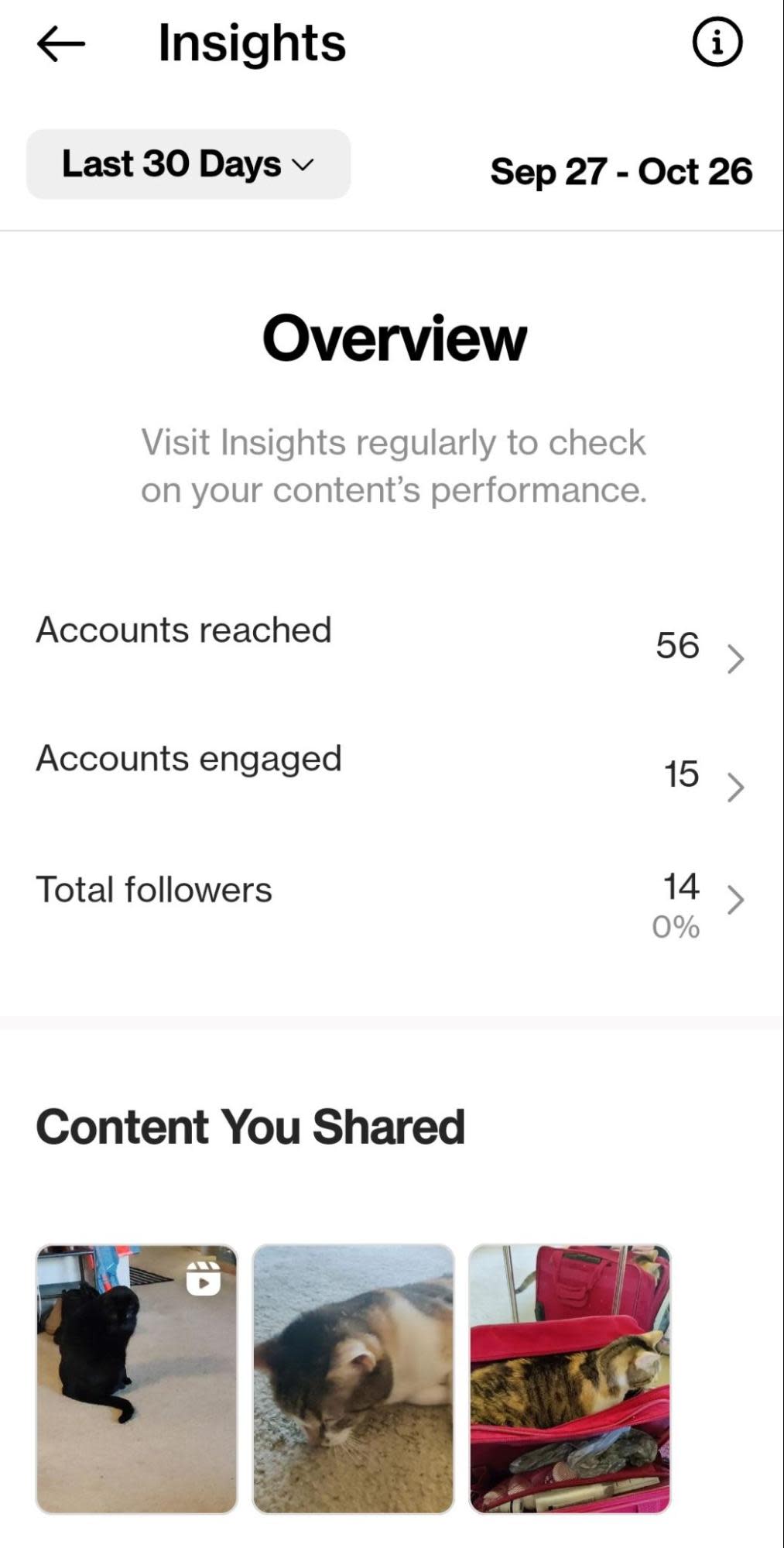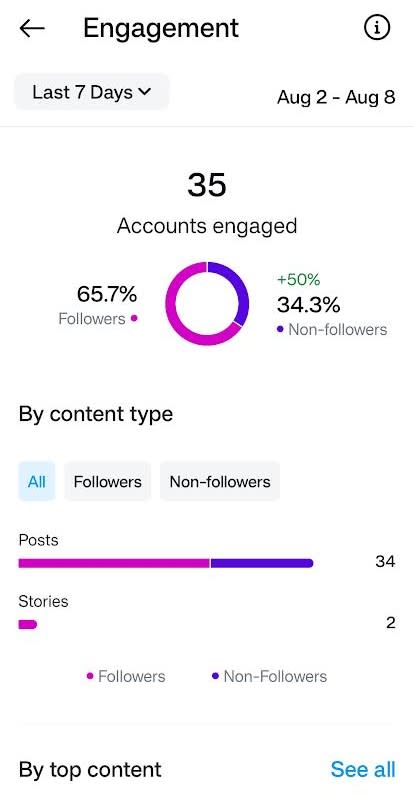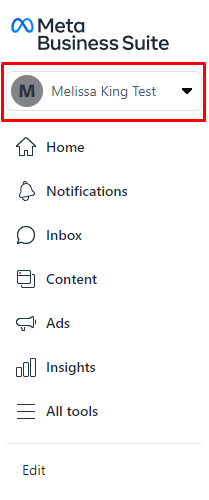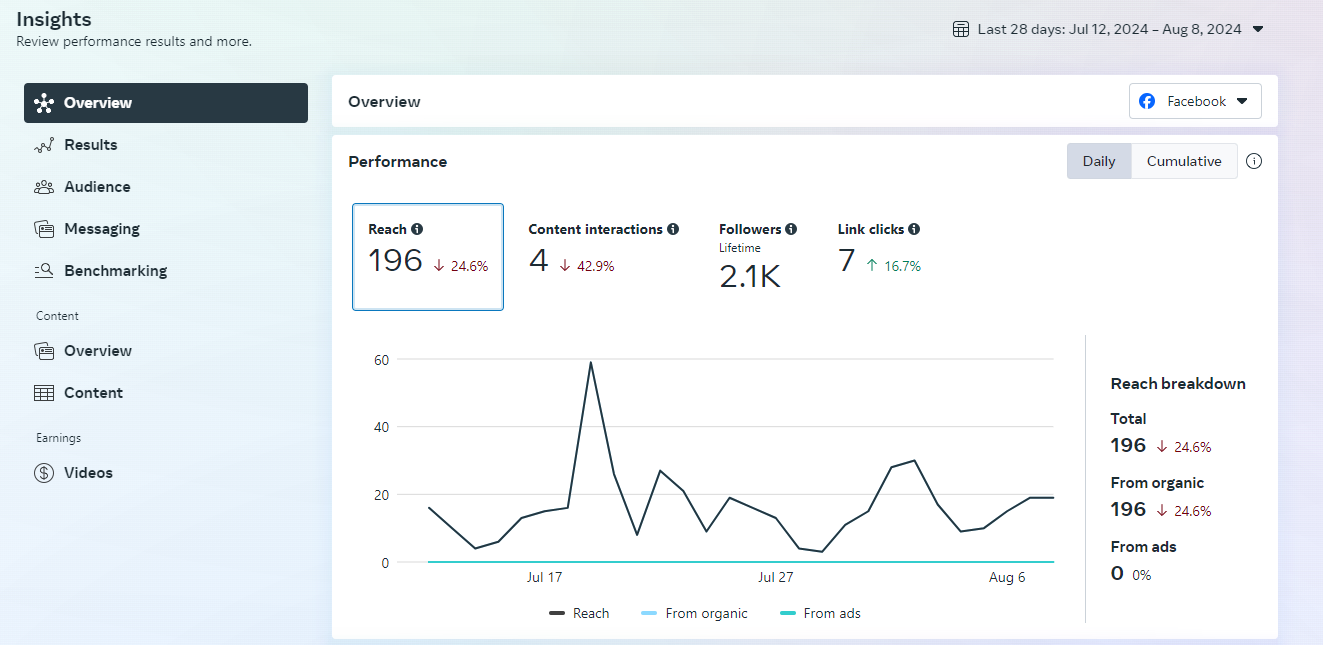As you research Instagram management tips, you’ll find tons of marketers hyping up analytics and explaining how to check them. That’s important, but they don’t tell you what you should do with those analytics. You know your post has 100 likes, but what does that mean in the grand scheme of your social media strategy?
I’m going to show you how to check your Instagram analytics and figure out what they can tell you about the big picture.
Table of contents:
How to check analytics on Instagram
Instagram has a robust analytics platform in its own app. The catch is that you can only access them on the mobile version. Here’s how to check Instagram analytics straight from the source.
The main Insights page
Before you can check your account’s analytics, Instagram requires you to switch to a business or creator account.
-
Go to your profile, and click on the three lines in the upper-right corner of the screen.
-
Click Account type and tools under For professionals.
-
Choose Switch to professional account to change your current account to a professional one or Add new professional account to create an additional, new professional account.
-
Once you have a professional account, you can go back to the three-line menu and click on Insights to see Instagram analytics.
The main Insights page provides an overview of your account activity for the time you specify in the dropdown menu at the top of the screen.

This page has two sections:
-
Overview: Here you’ll see the number of accounts your content reached, the number of accounts that engaged with your content, and your total followers for the time. Click on each stat to go into a dedicated analytics page.
-
Content You Shared: This section shows the content you shared during the time, with clickable sections for different content types. It directs you to individual posts for analysis.
Now, let’s dig into each of the sections you can visit in Instagram Insights.
Accounts reached

The Accounts reached section explores your reach—the number of people who saw your posts. It covers the following metrics:
-
Accounts reached: The number of accounts that came across any of your posts, plus the ratio of followers to non-followers among the users you reached
-
Impressions: The number of times people came across your posts, including repeat visits from the same user
-
By content type: Your reach organized by type of content
-
By top content: Posts, Stories, Reels, videos, and Live videos that received the most reach in the period
-
Reached audience: The demographics of the audience you reached, including countries, cities, gender, and age ranges
-
Profile activity: Actions taken on your profile, such as profile visits and website taps
Accounts engaged

In the Accounts engaged section, you’ll find stats related to the times people engaged with your posts, such as:
-
Accounts engaged: The number of accounts that engaged with your content and follower to non-follower ratio of accounts involved in that engagement
-
By content type: The number of interactions your content received broken down by content type
-
By top content: Top Stories, posts, Reels, videos, and Live videos by engagement
-
Content interactions: The total number of interactions—such as comments and likes—on your content in the specified time
-
Post interactions: The total number of interactions with your posts categorized into likes, saves, and shares
-
Top posts: Your best-performing posts based on the number of likes
-
Audience: The locations, gender, and age of the people who engaged with your content
Followers

Your Instagram Followers analytics include numbers on follower traits and behavior like:
-
Followers: Total number of followers, plus the percentage growth of followers you received in the specified time
-
Growth: Overall follower trends, covering follows and unfollows
-
Top locations: Most frequent locations for your followers
-
Age range: Most common ages for your followers, organizable by all genders, men, and women
-
Gender: Percentage of followers who are men and women
-
Most active times: Your followers’ most popular times to use Instagram, organizable by hour or day
Checking Insights for specific posts, Stories, Live Videos, and Reels
You can see analytics for a specific piece of content by visiting it from Insights’ Content You Shared section or your profile. For a post or Reel, you’ll click the View insights link right below it.

For other content:
That link will give you a detailed look into your content’s stats, including:
-
Plays, likes, comments, shares, and saves
-
Accounts reached
-
Interactions
-
Engagement from followers vs. non-followers
-
Profile activity resulting from this content
Each type of content has unique analytics pages and metrics. For example, Stories have metrics about swiping behavior, while videos include info on watching patterns.
How to check Instagram analytics on Meta Business Suite
Meta Business Suite lets you look at your Instagram and Facebook metrics side-by-side on desktop or mobile. It gives you a different set of analytics than Instagram Insights does, so it can give you new perspectives on your performance. Go to Meta Business Suite by visiting https://business.facebook.com/.
If you haven’t already, create a Meta business portfolio and connect it to your Instagram following the Meta help center’s instructions. You might already have your Facebook and Instagram pages in the Business Suite if they were pulled in from previous versions of Facebook’s backend.
Manage multiple pages? Find your Instagram page by going to the top of the left-hand menu and clicking the dropdown menu with your page’s name.

See Instagram analytics in Meta Business Suite by clicking the Insights option in the left-hand menu. There, you’ll have access to the following tabs:
-
Overview: A quick overview of your overall performance, plus recommendations for growing your reach and a summary of your messaging metrics
-
Results: Page reach, visits, and followers
-
Audience: Current audience’s ages, location, and gender compared to the full Meta audience and their most active times
-
Benchmarking: Your profile’s performance compared to profiles for similar businesses
-
Content Overview: Reach, engagement, and top content formats
-
Content: A list of all your ads, posts, and Stories with detailed engagement metrics
-
Video Earnings: Earnings from video ads on Meta platforms

How to get Instagram analytics using a social media management tool
You can also get Instagram analytics through a social media management tool. These apps let you schedule posts and look at analytics for multiple platforms in one app, but you’ll usually need a paid plan for more than surface-level analytics.
The level of depth you’ll get for a third-party analytics tool depends on the app you choose. But they tend to pull many of the same analytics you’ll find in Instagram Insights or Meta Business Suite. Smaller-scale businesses and creators can get away with sticking to native tools, as long as they don’t mind clicking through multiple interfaces. That approach can get harder as you scale your business and accounts, though.
Take a look at Zapier’s list of the best social media management tools or the best Instagram scheduling apps to start your research.
Which Instagram metrics to pay attention to (and how to optimize them)
Here’s how to understand some common Instagram analytics metrics categories and what to do to optimize them. Look how these groups directly correspond to the sections in Instagram’s Insights—they’re each an important touchpoint in understanding your social media’s results.
Reach
Metrics such as accounts reached and reached audience relate to reach: the number of accounts that see your content.
Check the balance of followers versus non-followers in Instagram Insights to better understand who comes across your posts. If you don’t see many non-followers seeing your content, you might benefit from strategies to increase your reach.
-
Give trending audio a shot. Users can check trending audio to see what other posts use it, giving your post another channel for exposure. Even better—the Instagram algorithm considers trending audio in its suggestions, meaning that someone who likes a different Reel with the same audio might see yours. Go to Trending audio near the bottom of the professional dashboard’s main page to see what people like to use right now.
-
Mix up your content formats. Buffer recommends switching up your format within the same type of post. Dabble in trending and original audio in Reels, and try different Story formats to see what your audience responds to.
-
Team up on collaborative posts. Make collaborative posts with other brands to have your content show up to both accounts’ followers. Tap Tag people and Invite collaborator when making a post to turn it into a collab, or ask someone to do the same for you.
Engagement
Engagement metrics involve your audience’s interactions with your posts, such as likes and comments. They signify your content’s relevance to your audience. Instagram also has unique engagement metrics, such as swipes on Stories and taps on website links.
Check your engagement rate by dividing your total engagements by your followers, then by people reached. This ratio shows how many of the people seeing your content actually engage with it. For your reference, the RivalIQ benchmark report discovered a median engagement rate of 0.43% using the follower calculation.
If you’re happy with that rate but want to increase your overall numbers, go back to your reach and work on strategies there. Meanwhile, if you want to increase your engagement rate, add these tactics to your strategy:
-
Make your content more personal and relevant to your audience. As Zapier’s guide to creating content that sells shows, engaging content puts people first and your brand second. Think about your audience and what they want to see on their feed.
-
Add calls to action to your content. Later advises asking your audience questions to start a conversation in your comments. You can also include a more traditional call to action that encourages people to click your link in bio.
-
Engage with your audience. As Sprout Social points out, you can’t underestimate the power of interacting with your followers. Share user-generated content, and reply to comments to show you’re worth engaging with.
Audience behavior
Instagram also has metrics related to audience behavior that don’t have “bad” results, but they can influence how you share content with your audience. The demographics and most popular times in Instagram Insights help you match your content to your intended audience and develop an ideal posting schedule.
For example, if your demographics skew older and you don’t see your meme posts performing, you could try more informative posts. Or, you notice your audience using Instagram at 2 p.m., but you post at 8 a.m. Changing one of your posting times to 2 p.m. will put your content at the top of their chronological feeds.
If your demographics data doesn’t quite match the audience you had in mind, you might need to research your target audience. You could also use that new data as evidence for a new target audience.
Automate your Instagram account
Now that you know how your Instagram performance plays into your social media strategy, you can focus more of your efforts on that strategy by automating all your repetitive Instagram workflows.
Zapier connects Instagram with thousands of other apps, so you can do things like automatically cross-post across channels, get alerts when your account is tagged, or post new products to Instagram. Learn more about how to automate Instagram for your business, or get started with one of these pre-made workflows.
Zapier is workflow automation software that empowers anyone to create complete, customized, automated solutions. Combine user interfaces, data tables, and logic with thousands of apps to build and automate anything you can imagine. Check out this page to learn how Zapier works.
Related reading:
This article was originally published in November 2022. The most recent update was in August 2024.